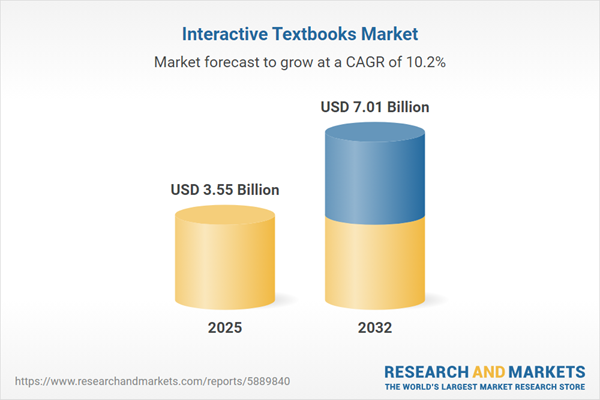Speak directly to the analyst to clarify any post sales queries you may have.
The Interactive Textbooks Market empowers enterprises and educational organizations to achieve scalable, adaptive digital learning, supporting rapid upskilling, compliance alignment, and future-ready workforce development. Senior decision-makers are leveraging interactive content technologies to standardize training and drive organizational agility in an evolving global environment.
Market Snapshot: Interactive Textbooks Market Size and Growth
The global Interactive Textbooks Market reached a valuation of USD 3.21 billion in 2024 and is projected to expand to USD 3.55 billion by 2025, ultimately attaining USD 7.01 billion by 2032. The market is experiencing a compound annual growth rate of 10.22%, reflecting accelerating adoption as organizations transition to digital-first educational delivery for K-12, higher education, workforce training, and professional development. Enterprises and educational institutions are increasingly investing in cloud-based learning solutions seeking efficient content administration, cost optimization, and greater learner engagement. For leaders, interactive textbooks offer a framework for aligning training with business goals while fostering a culture of continuous improvement.
Scope & Segmentation of the Interactive Textbooks Market
Diversification within the Interactive Textbooks Market enables organizations to customize procurement, deployment, and investment strategies. Key segmentation factors drive market relevance and facilitate targeted decision-making:
- End User: Corporate professionals, academic institutions, vocational training organizations, and K-12 schools use interactive materials to address compliance, competency advancement, and sector-specific learning objectives.
- Application: Offerings include interactive eBooks, learning management system modules, mobile applications, and web-based learning platforms, supporting both academic and workplace scenarios.
- Deployment Mode: Cloud, on-premise, and hybrid implementations provide organizations with flexibility based on IT infrastructure and security compliance needs.
- Pricing Model: Choices such as freemium, pay-per-use, subscription, and perpetual licensing align digital content investments with organizational financial strategies.
- Subject Area: Business, STEM, compliance, and humanities materials support industry-specific training, regulatory requirements, and general skill development.
- Regional Coverage: The Americas, Europe, Middle East and Africa, and Asia-Pacific exhibit distinct regulatory environments, infrastructure capabilities, and market maturity—factors influencing local adoption and strategy.
- Key Players: Major companies including Pearson plc, Cengage Learning, McGraw-Hill Education, John Wiley & Sons, Houghton Mifflin Harcourt, Scholastic, RELX, Holtzbrinck, Wolters Kluwer, and VitalSource Technologies are advancing technology partnerships and digital content solutions.
These segmentation criteria provide senior leaders with a framework for market evaluation, customization of digital learning ecosystems, and strategic alignment with compliance and sector mandates.
Key Takeaways for Senior Decision-Makers
- Interactive textbooks support digital transformation initiatives, enabling seamless integration of blended, in-person, and online learning within enterprise and academic settings.
- Data analytics built into platforms provide real-time insights into learner engagement and performance, allowing continuous optimization of training programs.
- Cloud and mobile-compatible solutions empower dispersed teams, allowing flexible access to standardized training materials regardless of location.
- Collaboration between leading publishers and technology solution providers ensures adaptability to regulatory updates and evolving operational policies.
- Localized content and user experience customization reduce adoption barriers, accommodating regional, cultural, and sector-specific requirements.
- Flexible licensing models and scalable deployment help organizations adjust as business strategies evolve or as new challenges in workforce development arise.
Tariff Impact on Interactive Textbooks Procurement and Strategy
Recent adjustments in US tariff policies have prompted changes in procurement and IT deployment, particularly where supply chains link to global digital device manufacturers. Organizations are increasingly adopting cloud services aligned with regional regulations to ensure persistent access to interactive learning materials while maintaining regulatory compliance. Broadening vendor portfolios and utilizing adaptable deployment strategies help maintain continuity in employee and student training, supporting talent development despite international trade complexities.
Methodology & Data Sources
This analysis is based on the synthesis of secondary research, industry expert interviews, and carefully structured market surveys. All findings are validated by specialists focused on the Interactive Textbooks Market to ensure decision-making utility, relevance, and data accuracy for organizational strategy development.
Why This Report Matters
- Provides senior leaders with actionable insights to benchmark digital content investments and learning outcomes in a competitive global landscape.
- Supports strategic, data-driven procurement and compliance efforts for leaders in learning and development, information technology, and education management.
- Delivers practical guidance for implementing and scaling digital training programs amid diverse regulatory and organizational environments.
Conclusion
The Interactive Textbooks Market offers a strong foundation for responsive, future-focused digital learning, enabling organizations to meet evolving compliance demands and workforce training objectives across global markets.
Additional Product Information:
- Purchase of this report includes 1 year online access with quarterly updates.
- This report can be updated on request. Please contact our Customer Experience team using the Ask a Question widget on our website.
Table of Contents
3. Executive Summary
4. Market Overview
7. Cumulative Impact of Artificial Intelligence 2025
Companies Mentioned
The companies profiled in this Interactive Textbooks market report include:- Pearson plc
- Cengage Learning, Inc.
- McGraw-Hill Education, LLC
- John Wiley & Sons, Inc.
- Houghton Mifflin Harcourt Company
- Scholastic Corporation
- RELX PLC
- Holtzbrinck Publishing Group GmbH & Co. KG
- Wolters Kluwer N.V.
- VitalSource Technologies, LLC
Table Information
| Report Attribute | Details |
|---|---|
| No. of Pages | 180 |
| Published | October 2025 |
| Forecast Period | 2025 - 2032 |
| Estimated Market Value ( USD | $ 3.55 Billion |
| Forecasted Market Value ( USD | $ 7.01 Billion |
| Compound Annual Growth Rate | 10.2% |
| Regions Covered | Global |
| No. of Companies Mentioned | 11 |









